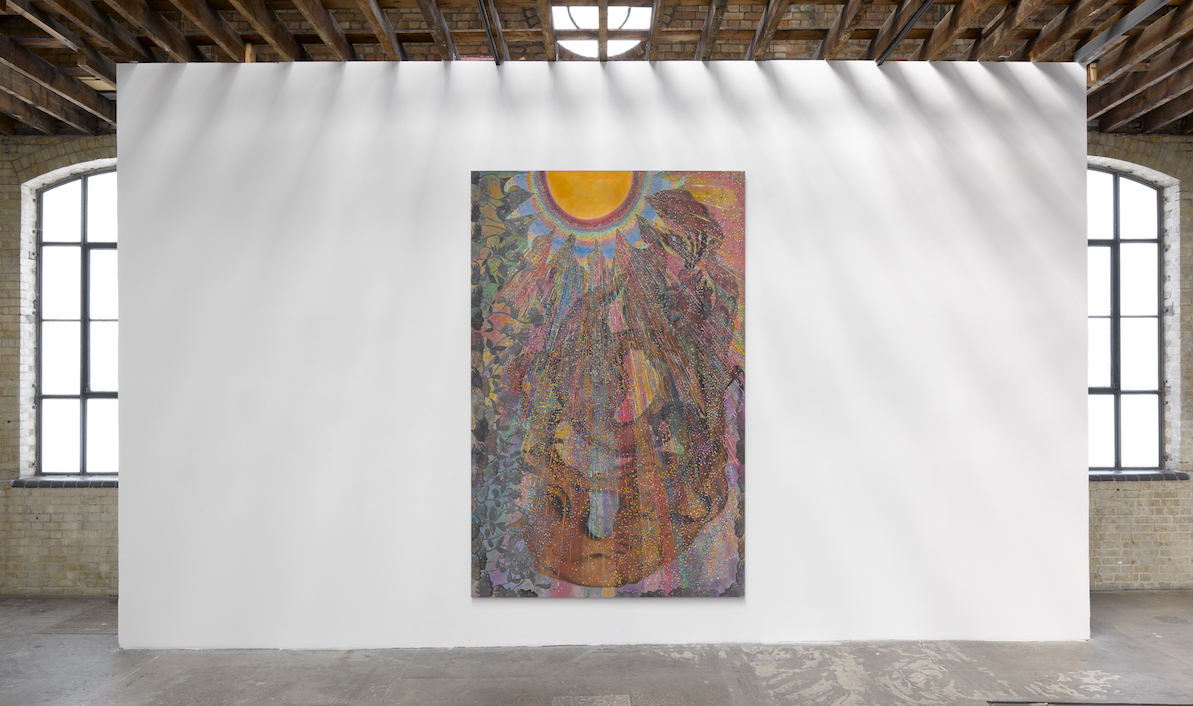Chris Ofili’s current exhibition at Victoria Miro begins with ten etchings inspired by Stéphane Mallarmé’s 1876 poem L’Après-midi d’un faune. This series entitled Pink Daydreams of a Faun has significant connections to The Seven Deadly Sins. The world of both is well described by Minna Moore Ede, who writes of being summoned into “a natural world of waterfalls and magical flowers, longhaired nymphs and a mystical faun whose dreams become our dreams as our eye explores shapes that morph from one thing into another.” Here, “Water and watercolour merge and dissipate in front of our eyes” while “Lines are confident and continuous as well as free-flowing.”
‘I think the works are more about the inner feelings one has about the sin – not necessarily only in the moment of committal – than about what happens afterwards, or the idea of judgement.’ Chris Ofili
In this exhibition, Ofili gives us paradisical images that draw on his experience of the mystery and folklore of Trinidad, where he has lived since 2005. These are also images in which the coloured dots of Pointillism are set free to flood and flow over his images of paradise, as does water, air, or the nature of dreams. The natural world, as depicted here, is fecund and mysterious, a place where magnetic forces of attraction and repulsion hold sway. These seem to have been born of a liminal, trance-like state, between waking and sleeping, with strange visions swimming up into the mind’s eye from a creative, playful place in the unconscious.

As such, Ofili is depicting the pleasure principle involved in sin and not the judgement on which the concept of the Seven Deadly Sins has traditionally been based. Ofili has said, ‘I think the works are more about the inner feelings one has about the sin – not necessarily only in the moment of committal – than about what happens afterwards, or the idea of judgement.’ To see this more clearly, we might contrast Ofili’s beautifully expansive works with the tightly focused claustrophobia of Peter Howson’s apocalyptic images as seen in his current City Art Centre Edinburgh retrospective. In Howson’s images, too many people are too close together, touching in ways that make their flesh crawl and bodies writhe, while in Ofili’s images, there is a sense of natural flux and flow to the interactions depicted.
Ofili’s focus is either on moments when sin is conceived – moments which, to be effective as temptations, must be attractive to us – or could represent a reconfiguring of our concept of sin. Suppose heaven, as some theologians have suggested, involves a simple enjoyment of relationships with the divine, other human beings, and the creatures and plants of creation. In that case, isolation becomes the key sin, making Ofili’s imagery fully paradisical without any sense of impending judgement.
In these paintings, figures of satyrs, fauns and women interact and intertwine whilst enveloped in nature, whether waterfall, forest or sky. The movement within which figures are enveloped includes a plume of smoke rising from a bowl, a waterfall flowing over and down, and the sun’s rays casting prismatic striations down and across. Exotic flowers sprout from the mouths of many of the figures revealing the fertility of this magical space while figures swing sensually and ecstatically or are crowned or reclining and rest. Only in The Fall From Grace do we see any sign of concern or consequence, and here the issue seems to be that of Icarus, flying too close to the sun with inadequate preparation.
The Harvester sees a catalytic or permissive figure spanning the fecund landscape below it. This is a figure that recurs in Ofili’s recent work and features in a display at Tate Britain of Ofili’s watercolours and sketches that resonate with the work of William Blake. Ofili has said, “I first came across William Blake’s work at the Tate Gallery around the time I began studying art in 1987, whilst I was living in Manchester.” He was “drawn in by the beautiful line and gentle use of colour, and by how the figures, the landscape and the symbolism all metamorphose fluidly into each other.” These features of Blake’s work are now characteristic of Ofili’s work too. He says, too, “I’m always shocked by how imaginative Blake is, how free and open the work is, and how he’s describing this world in what appears to be a kind of fairytale world.” Again, these factors are also now characteristic of Ofili as he freely mixes influences from diverse sources – with Biblical stories flowing into Caribbean folklore and Greek myths – to create works that are partly figurative and partly abstract. Playing on ideas of beauty, Ofili’s art, like that of Blake, is vibrant, symbolic, and frequently mysterious in nature.
This exhibition and these paintings seem to have the aim of initiating a conversation about sin and its nature. Accordingly, two books accompany the exhibition. One includes Mallarmé’s L’Après-midi d’un faune and an essay by Minna Moore Ede, who traces its legacy across works by Debussy, Manet, Nijinsky and others and considers its influence as a generative impulse in Ofili’s work. For the other, Ofili invited seven writers – Hilton Als, Inua Ellams, Marlon James, Anthony Joseph, Ayanna Lloyd Banwo, Attillah Springer and Lynette Yiadom-Boakye – to contribute new writing. Like Ofili’s paintings, their poems and narratives are not confined to illustrating single sins but meditate, personally and expansively, on the seven deadly sins.
Like the figures in The Fountain, we – the artist, the writers and ourselves as viewers – gather around these images, poems, stories and essays to see what emerges and to become one with the visions and dreams that rise and return.
Words by Rev Jonathan Evens
Chris Ofili: The Seven Deadly Sins and Pink Daydreams of a Faun, 2 June–29 July 2023, Victoria Miro
Visit Here
Chris Ofili, Ongoing, Room 7B, Tate Britain
Visit Here

